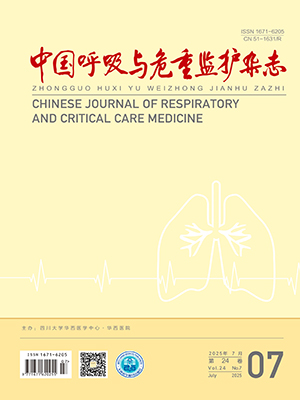| 1. |
Laporte L, Hermetet C, Jouan Y, et al. Ten-year trends in intensive care admissions for respiratory infections in the elderly. Ann Intensive Care, 2018, 8(1): 84.
|
| 2. |
Cillóniz C, Dominedò C, Garcia-Vidal C, et al. Community-acquired pneumonia as an emergency condition. Curr Opin Crit Care, 2018, 24(6): 531-539.
|
| 3. |
Torrini F, Gendreau S, Morel J, et al. Prediction of extubation outcome in critically ill patients: a systematic review and meta-analysis. Crit Care, 2021, 25(1): 391.
|
| 4. |
Di Dedda U, Ascari A, Fantinato A, et al. Microcirculatory alterations in critically ill patients with COVID-19-associated acute respiratory distress syndrome. J Clin Med, 2022, 11(4): 1032.
|
| 5. |
Kanoore Edul VS, Caminos Eguillor JF, Ferrara G, et al. Microcirculation alterations in severe COVID-19 pneumonia. J Crit Care, 2021, 61: 73-75.
|
| 6. |
Ospina-Tascón GA, Bautista DF, Madriñán HJ, et al. Microcirculatory dysfunction and dead-space ventilation in early ARDS: a hypothesis-generating observational study. Ann Intensive Care, 2020, 10(1): 35.
|
| 7. |
Abou-Arab O, Beyls C, Khalipha A, et al. Microvascular flow alterations in critically ill COVID-19 patients: a prospective study. PLoS One, 2021, 16(2): e0246636.
|
| 8. |
中华医学会呼吸病学分会. 中国成人社区获得性肺炎诊断和治疗指南(2016年版). 中华结核和呼吸杂志, 2016, 39(4): 253-279.
|
| 9. |
张晓蕾, 李莉, 彭倩宜, 等. 感染性休克患者舌下微循环障碍分型及与预后的研究初探. 中华内科杂志, 2021, 60(10): 898-903.
|
| 10. |
王小亭, 刘大为, 于凯江, 等. 中国重症超声专家共识. 中华内科杂志, 2016, 11(55): 900-912.
|
| 11. |
Prina E, Ranzani OT, Torres A. Community-acquired pneumonia. Lancet, 2015, 386: 1097-1108.
|
| 12. |
Fang WF, Yang KY, Wu CL, et al. Application and comparison of scoring indices to predict outcomes in patients with healthcare-associated pneumonia. Critical care, 2011, 15: R32.
|
| 13. |
Song JH, Oh WS, Kang CI, et al. Epidemiology and clinical outcomes of community-acquired pneumonia in adult patients in Asian countries: a prospective study by the Asian network for surveillance of resistant pathogens. Int J Antimicrob Agents, 2008, 31: 107-114.
|
| 14. |
Guo SR, Mao XH, Liang M. The moderate predictive value of serial serum CRP and PCT levels for the prognosis of hospitalized community-acquired pneumonia. Respir Res, 2018, 19(1): 193.
|
| 15. |
刘春桃, 付敏, 陈希, 等. 无创通气失败风险预测模型的研究进展. 中国呼吸与危重监护杂志, 2022, 21(9): 678-684.
|
| 16. |
马德胜, 甄玲玲, 马莉, 等. 经鼻高流量氧疗在慢性阻塞性肺疾病急性加重期的研究进展. 中国呼吸与危重监护杂志, 2022, 21(9): 670-673.
|
| 17. |
彭拓, 张媛莉. 舌下微循环测量指标的研究进展. 医学理论与实践, 2020, 33(12): 4.
|
| 18. |
Pinheiro T, Freitas F, Coimbra K, et al. MOESM1 of short-term effects of passive mobilization on the sublingual microcirculation and on the systemic circulation in patients with septic shock. Ann Intensive Care, 2017, (7): 95.
|
| 19. |
Ltaief Z, Schneider AG, Liaudet L. Pathophysiology and clinical implications of the veno-arterial PCO2 gap. Critical Care, 2021, 25(1): 318.
|




